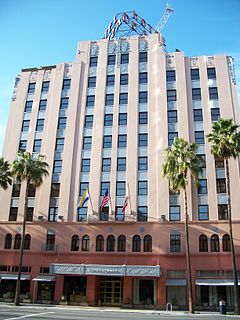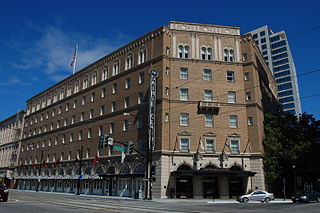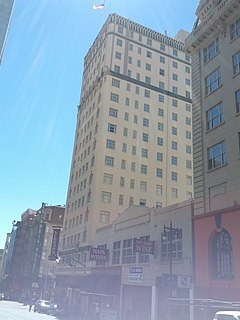
Stiles Oliver Clements was an architect practicing in Los Angeles and Southern California.

United Office Building, now known as the Giacomo, is a historic Mayan Revival, a subset of art deco, skyscraper in Niagara Falls, New York, US.

U.S. Route 66 is a part of a former United States Numbered Highway in the state of California that ran from the west in Santa Monica on the Pacific Ocean through Los Angeles and San Bernardino to Needles at the Arizona state line. It was truncated during the 1964 renumbering and its signage removed in 1974. The highway is now mostly replaced with several streets in Los Angeles, State Route 2 (SR 2), SR 110, SR 66, San Bernardino County Route 66 (CR 66), Interstate 15 (I-15), and I-40.

The Culver Hotel is a national historical landmark in downtown Culver City, California. It was built by Harry Culver, the founder of Culver City, and opened on September 4, 1924, with local headlines announcing: "City packed with visitors for opening of Culver skyscraper." Originally named Hotel Hunt, and later known as Culver City Hotel, the six-story Renaissance Revival building was designed by Curlett & Beelman, the architecture firm behind renowned Art Deco buildings throughout Los Angeles, including downtown Los Angeles' Roosevelt and Eastern Columbia buildings.

Mayan Revival is a modern architectural style popular in the Americas during the 1920s and 1930s that drew inspiration from the architecture and iconography of pre-Columbian Mesoamerican cultures.

Robert Stacy-Judd (1884–1975) was an English architect and author who designed theaters, hotels, and other commercial buildings in the Mayan Revival architecture Style in Great Britain and the United States. Stacy-Judd's synthesis of the style used Maya architecture, Aztec architecture, and Art Deco precedents as his influences.

The Hotel De Anza is a historic hotel in San Jose, California. At ten stories, it once was the tallest hotel in the San Jose central business district, prior to the construction of Hilton, Fairmont, and Marriott hotels. Significant for its architectural style, it is one of San Jose's few Zig Zag Moderne buildings. The hotel was listed on the National Register of Historic Places on January 21, 1982.

The Westin San Jose, housed in the historic Sainte Claire Hotel, is a six-story landmark hotel in Downtown San Jose, California, United States. Built in 1926, it is listed on the National Register of Historic Places and one of the city's most recognized architectural landmarks.

The San Dimas Hotel, also known as Walker House, the Carruthers Home, and the San Dimas Mansion, is a historic structure in San Dimas, California, built by the San Jose Ranch Company in 1887. Originally built as a hotel, the 15,000-square-foot (1,400 m2) structure had 33 rooms and 14 fireplaces. The hotel was built in anticipation of a land boom that never happened, and it never had a paying guest. In 1889, the property was sold to James W. and Sue Walker for $25,000. After being occupied by seven generations of Walkers, the property was turned into a restaurant in 1979. The building became vacant in 1997 and was later acquired and renovated by the City of San Dimas. It was listed on the National Register of Historic Places in 1972.
Francisco Cornejo was a Mexican painter and sculptor, specialized in Maya and Aztec themes. He was influenced by Pre-Columbian art.
In the United States, the National Register of Historic Places classifies its listings by various types of architecture. Listed properties often are given one or more of 40 standard architectural style classifications that appear in the National Register Information System (NRIS) database. Other properties are given a custom architectural description with "vernacular" or other qualifiers, and others have no style classification. Many National Register-listed properties do not fit into the several categories listed here, or they fit into more specialized subcategories.

The Hollywood Roosevelt Hotel is a historic hotel located at 7000 Hollywood Boulevard in the Hollywood district of Los Angeles, California. It opened on May 15, 1927, and is the oldest continually operating hotel in Los Angeles.

The Mission Revival style was an architectural movement that began in the late 19th century for a colonial style's revivalism and reinterpretation, which drew inspiration from the late 18th and early 19th century Spanish missions in California. It is sometimes termed California Mission Revival, particularly when used elsewhere, such as in New Mexico and Texas which have their own unique regional architectural styles.

First Baptist Church of Ventura is a historic church at 101 S. Laurel Street in Ventura, California. It was built in 1926 and renovated extensively into the Mayan Revival style in 1932. Declared a landmark by the City of Ventura In 1975, the building was added to the National Register of Historic Places in 2009. Since 1952, it has been home to the Ventura Center for Spiritual Living.
Pueblo Deco is an architectural style in the Southwestern United States popular in the early 20th century. Pueblo Deco fused elements of Art Deco with the region's Pueblo and Territorial architectures, themselves inspired by Pueblo and Territorial Styles. Early Pueblo Deco design was influenced by architect Mary Colter's work, which incorporated Native American elements. The term was popularized by author Carla Breeze, whose 1984 Pueblo Deco: The Art Deco Architecture of the Southwest and 1990 Pueblo Deco books described the fusion of southwestern motifs with the popular Deco style. Notable examples of buildings incorporating Pueblo Deco elements include the KiMo Theater in Albuquerque, New Mexico and the Arizona Biltmore Hotel in Phoenix, Arizona.

The Cosmopolitan Hotel and Restaurant in the Old Town San Diego State Historic Park is a registered national historic landmark, built in the early 19th century by Juan Bandini and later purchased by Albert Seeley to serve as a stagecoach hotel. In 2010, restorations and added fine dining restaurant revived the hotel to its 1870s charm, making it again a focal point of the original downtown area.

The Spero Hotel, originally the Hotel Californian and later the Serrano Hotel, is a historic hotel building in San Francisco, California. It was designed by Edward E. Young and built in 1923. A four story addition designed by Alfred Henry Jacobs was completed in 1929. The 12-story hotel is at 405 Taylor Street. It underwent a $16 million renovation and became the Spero Hotel in 2018. It is listed on the listed on the National Register of Historic Places in San Francisco, California.

Historic Hotels of America is a program of the National Trust for Historic Preservation that was founded in 1989 with 32 charter members; the program accepts nominations and identifies hotels that have maintained their authenticity, sense of place, and architectural integrity. As of June 5, 2015, the program included over 260 members in 44 states, including the District of Columbia, Puerto Rico, and the U.S. Virgin Islands.
Samuel Newsom was a Canadian-born American architect. Together with his brother Joseph Cather Newsom founded the architecture firm Newsom and Newsom, practicing in Northern and Southern California. Their most celebrated house is the Carson Mansion in Eureka, California.


















